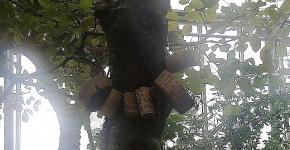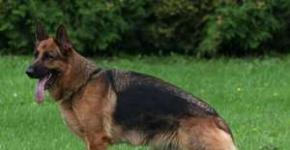Standards breed German shepherd. German Shepherd Anatomy
We will describe only some german Shepherd Characteristics (breed standard) and give schemes to help you better evaluate your pet or your future puppy's parents.
If you compare a dog and a bitch, sex differences are immediately apparent. Male stronger, larger and more majestic. In his view, attention and charm of imperiousness, because in wolf and dog packs the leader is always a male.
The female, on the contrary, should have a tender and devoted look due to her role as a mother. No matter how beautiful the dog is, it does not ideally meet the standard if its gender is not visible in the eye. The German Shepherd should have erect ears and an elongated muzzle, which is typical for an adult wolf. Puppies on the contrary hanging ears and a rounded muzzle.
Such forms of the Caucasian Shepherd, whose psyche is inhibited at an earlier stage, will retain until adulthood. straining the ears most often at the moment of anxiety. But a genetically correct dog begins to keep them always raised from 4 to 8 months, although owners usually begin to worry about this in 4.5 months.
However, the concern should rather cause a little puppy German shepherd , whose ears are already standing. This may be a sign of general physique weakness. Healthy and strong puppies have large, heavy ears, so they later learn to strain them. A weak puppy has small and light ears - it is easier for them to lift them.
Looking around the head of an adult dog, we see that the length and width of the skull are the same. The ratio of the length of the muzzle to the length of the skull is also 1 to 1 st. Therefore, experts say that the German Shepherd mezotsefal.
The eyes of the German Shepherd should have a semi lateral location and be dark in color. It is difficult to find a very dark eye color, so there is a tendency to reject only very yellow eyes, considering them to be a breed defect, because they give the look an expression of coldness and distrust. Acceptable eye color ocher or reddish.
Of course, the darker the eye, the more preferable it is. The ears of the German Shepherd Dog are wide at the base with a sharp tip, set high, upright. Teeth must be properly seated. Bite on the type of scissors. Bite on the type of mites is considered a defect, as well as protruding lower or upper jaw.
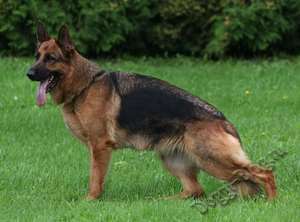
Let's go to torso and limbs. We will examine them during the movement of the dog at a trot. The German Shepherd is not just a runner, but an extreme runner. It is able to run, as long as possible, with as little as possible with less effort, long trotting movements: powerfully and quickly. Since the impulse of movement is born in the back of the body, the ideal addition of the German Shepherd is the one that will ensure the transfer of impulse from the back of the body to the front in the most economical way.
Look around the neckwhich in motion balances between the head and torso. The ideal neck should be rather long, about 35% of the height of the dog at the withers. But the main thing - it should be separated from the well-discernable harmonious oblique line. With a perfect physique, the axis of the neck forms an angle of 45 degrees with a horizontal line and 90 degrees with the shoulder.
Now consider the interposition of the shoulder and forelimb. For the German shepherd, the angle between the shoulder blade and the shoulder is very important. Once it should have been as close as possible to a right angle. In fact, the right angle can not be found. Well, if this angle is from 98 to 110 degrees. Also important is the slope of the shoulder and shoulder relative to the horizontal line.
The angle of inclination of the blade should be approximately 54 degrees. Once they talked about 45 degrees, but this does not occur in life. The angle between the shoulder and the horizontal line is 55-60 degrees. The shoulder should not only have a good slope, but should also be long to provide the desired length of the step. Unfortunately, shoulder length is one of the main problems of modern dog breeders. In addition, less common straight shoulder.
The torso of the German Shepherd Dog, like the torso of all the dogs of cross-country breeds, can be inscribed in a rectangle. Its length should be equal to 11/10 of the height of the dog at the withers. The withers are the part of the dog's torso that lies behind the neck. It should be high with a backward slope in order to ensure good grip on the back and to ensure effective impulse transmission. With high withers, but without inclination, its fusion with the back is lost. The back becomes intermittent, and therefore defective. Eight dorsal vertebrae, following the withers form the actual back. It should also be long and sturdy.
The sacrum of the German Shepherd should be long, wide, with a good slope. It is anatomically shaped by the hip joints. Almost all muscles are attached to them, providing movement of the back of the body. The ideal angle of the sacrum is from 27 to 31 degrees. This ensures the continuity of the transfer of impulse movement of the back of the body with minimal effort.
Anatomical basis of the hind limbs large tibia and tibia. The impulse of movement largely depends on the angle of connection of these bones. The optimum angle is 120 degrees. With less stupid angle, the limb will lose strength. With more stupid, it will not be able to make a sufficiently wide step. We end naturally with a tail - an element of not last importance. After all, the tail protects the anus and genitals, is a means of communication for dogs, and during movement performs the most valuable steering function that regulates lateral movement.
According to standard german Shepherd Tail must be at least ankle-length But now it is impossible to find the tail only ankle length. Today often there are tails so long that the dog must bend them so that they do not drag on the ground. The tail can drag on the ground and if it is located too low and if the sacrum is too low and if the front of the body is too raised, as is the case with hyper-typical dogs. In any case, it is a defect.
1. General view
The German Shepherd is a medium height dog. The height at the withers is measured by a stadiometer from withers to the ground. When measuring, the vertical stand of the height meter should touch one of the dog’s elbows, and the dog’s coat should be firmly pressed against the dog’s withers.
The average height of the dog at the withers: for males - 62.5 cm, for females - 57.5 cm. Weight: males - 30-40 kg, bitches - 22-32 kg.
Growth tolerance is allowed 2.5 cm in one direction or another. Deviation from the average height of the dog by more than 2.5 cm significantly reduces the working and breeding value of the dog.
The German Shepherd has an elongated strong body with well-developed muscles.
The backbone of a German shepherd dog is dry, the constitution is strong. The harmonic relationship between the format of the dog and the angles of the articulations of the limbs provide a sweeping, long and light trot. The coat protects the dog in any weather.
It is necessary to strive for a good exterior, but not to the detriment of the working qualities of a shepherd dog.
Sexual dimorphism should be pronounced.
The German Shepherd, fully compliant with the standard, should initially give the impression of strength, proportionality of addition, ingenuity and agility.
Assessment of the manner of movement and temperament should be consistent with the adage: "In a healthy body there is a healthy mind," in other words, physically and mentally, the dog should always be ready for long-term work with large loads.
The ability of the German Shepherd to work can be assessed only by experienced specialists, therefore, experts specializing in judging German Shepherd Dogs should be involved in judging for trials. The same experts should give an assessment of the psyche, including an assessment of the reaction to the shot, and only a dog with the necessary training can receive a breeding assessment of "excellent". With any type of temperamental dog must obediently obey the trainer, adapt to any situation and with joy to the desire to work. The German Shepherd should make its own decisions when it is necessary to protect its owner or his property. During the attack, the German Shepherd Dog must be decisive and evil, but at the same time it must be completely manageable and unquestioningly carry out all the commands of the owner. In a calm situation, she should be obedient and affectionate, especially with children, not show aggression towards strangers and other animals, but she should be attentive and collected. In general, the German Shepherd should be impressed, inspire admiration and self-respect.
2. Movement and articulation of the limbs
The natural way of movement of the German shepherd is the lynx. The legs of the dog move consistently in a diagonal plane, in other words, if the front leg moves from one side of the body backwards, then the rear leg moves from the same side of the body forward. The German Shepherd should be folded in such a way that in the process of movement the back would take the minimum part - this is achieved the least expenditure of energy. The limbs of a dog must have such angles of articulation in which a dog without a significant change in the position of the back could carry the hind limbs forward to the middle of the body, and the front ones - by the amount necessary to ensure a wide-spread lynx. With the correct ratio of the length of the body to its height and proportional to the length of the limbs, the dog has a sweeping pitch, and the body keeps parallel to the ground - all this is necessary for a uniform translational motion. When the dog moves in an even trot, the head is extended forward, the tail is slightly raised and the line running from the tips of the ears through the neck and back to the end of the tail (top line) with no visible cavities forms a smooth straight line.
3. Type of behavior, nature and genetic predisposition
A special feature of the breed is a strong type of nervous system; attentiveness, naturalness of behavior, obedience, protection instinct, loyalty and integrity, as well as courage, fighting instinct and determination of actions are the most important qualities of the breed. The above features primarily give reason to consider the German Shepherd as a useful dog in a wide range, especially as a guard, patrol, protective and as a companion.
Excellent instinct combined with the ability for a long trot enables the German Shepherd to work reliably and tirelessly on the trail. These qualities allow the German Shepherd to be widely used in the search and rescue services.
4. Head
The proportions of the head should correspond to the size of the body. The length of the head is approximately 40% of the height of the dog at the withers. The head should not be coarse, not very light or too long, moderately wide between the ears.
The forehead is slightly rounded on the front and side, with or without a slightly pronounced transverse fissure. Cheeks slightly rounded, with a soft transition.
The skull is about half the total length of the head. When viewed from above, the head evenly narrows from the ears to the nose. The muzzle is wedge-shaped, elongated, dry, with well developed upper and lower jaws.
The width of the frontal part of the head should correspond approximately to its length. The proportions of the width of the frontal part of the head to its length in males are slightly larger than in females.
5. Teeth
Must be healthy, strong, complete - 42 teeth (20 on the upper and 22 on the lower jaw). The German Shepherd has a scissor bite. The incisors of the upper jaw should be placed on top of the incisors of the lower jaw.
Straight bite, overshot and undershot are flaws. The disadvantage is the presence of cracks between the teeth, as well as various options for a non-arched arrangement of incisors.
The jaws should be strong and strong, well developed, the teeth should sit deep in the gums.
6. Ears
Medium-sized, broad at the base, set high, pointed evenly from base to end, with shells looking forward.
Broken ears, drooping or cropped are a vice. The ears falling to the sides greatly spoil the exterior of the dog. Ears inclined inward are permissible in young animals during a tooth change, in adult dogs this is considered a disadvantage.
When moving or resting, many dogs hold their ears, which is not a drawback.
7. Eyes
Medium-sized, almond-shaped, slightly obliquely set, not bulging. The color of the eyes should match the color of the color, but preferably darker. The expression of the eyes must be energetic, intelligent, confident.
8. Neck
Strong, strong, well muscled, without dewlap. The angle of the neck to the horizon is about 45 °. When alarming, the neck rises a little, while running it drops.
9. Housing
The length of the body should be greater than the height of the dog at the withers and be 110-117% of the height at the withers. German shepherd dogs with a short body, square in format, high-legged to breeding should not be allowed.
The chest should be deep (about 45-48% of the height at the withers), but not too wide.
The lower part of the breast is as long and prominent as possible.
The ribs in the chest should be long and convex, but not barrel-shaped and not flat. They should reach the chest bone, which is at the level of the elbow joints. The chest of the correct form ensures the free movement of elbows in the trot.
An overly round rib cage causes the elbows of the forelimbs to twist out and the inharmonious movement of the shepherd dog.
Too flat chest causes a narrow set of the elbow joints of the forelimbs, with the chest is very elongated, and the loin is short.
The stomach is tightened moderately.
The back, including the lower back, straight, well muscled. The distance between withers and croup should not be too large.
Withers should stand out markedly over the back, be sufficiently high and long; the transition from the withers to the back should be smooth. Topline should be continuous, slightly descending to the croup.
The loin is wide, strong, muscular.
The croup is long, slightly sloping (the angle of inclination of the croup with respect to the line of the back is about 23 °). The croup is formed by the sacral and sciatic bones. Sharply sloping or straight croup is undesirable.
10. Tail
Fluffy, well overgrown, comes not less than to the hock, but should not be below the middle of the tarsus. At the end of the tail sometimes crooked, which is undesirable. At rest, the tail, hanging down, forms an arc; when excited and while moving, the tail rises and bends more strongly, but not above the back line.
When excited, the tail bends and rises slightly, but not above the back line.
The tail should not be twisted ring or be straight. Docking tail is not allowed.
11. Front limbs
The shoulder blades are long, set obliquely - at an angle of about 45 ° to the horizontal, tight to the chest. The humerus forms a right angle with the spatula. Shoulder and shoulder blade should be well muscled.
Forearm straight. The bones of the forearm and upper arm in cross section should be oval rather than round.
Pasterns are strong, the angle of inclination is approximately 20 ° from the vertical.
Elbows parallel, must not be turned either outward or inward. The forelegs should somewhat exceed the depth of the chest, this value is approximately 55% of the height at the withers.
12. Hind limbs
Hips wide, with strong muscles.
The femur is long and forms with a tibia, which is slightly longer than the femur, an indirect angle of about 120 °. The knee joint is approximately flush with the elbow joint.
The hock should be dry and strong. It is formed by the tibia with the bottom.
The hind limbs must be strong and muscular so that the dog can move freely and easily.
13. Paws
Rounded, arched, with tightly clenched short fingers. Paw pads should be hard, not cracked. Claws short, strong, dark color.
Dewclaws, sometimes found on the hind limbs, are removed at an early age.
14. Color
Black, with uniform brown, yellow, tan, crib with tan, crested (with black back), zonarno-gray or zononno-red with different shades, black, pure gray or gray with a light or brown tan.
Allowed, but undesirable, the presence of small white markings on the chest or very bright inner sides of the limbs. Nose should be black in any color. Dogs with a weak mask or no mask at all, with yellow or clearly bright eyes, large bright spots on the chest or on the inner sides of the limbs, as well as with light claws, red tail end or a general fuzzy weak color are considered to be slightly pigmented. The undercoat of all dogs, except black, always has a grayish tint. The final color of puppies can be determined only after the guard hair begins to grow.
15. Coat
German Shepherd Dog with a short hard coat
The tail coat should be as thick as possible. Separate guard hairs are straight, hard and tight to the body. On the head, including the inner part of the auricles, front legs, paws and toes, the hair is short, the neck is longer and thicker. On the back of the limbs, the fur is longer, down to the base of the metacarpus on the forelimbs and the hock on the back. On the hips are formed "pants" of medium size. The length of the coat is different, as a result there are many transitional forms. Too short, mole-shaped overgrown is a serious disadvantage.
German Shepherd with long tough coat
In the long-haired hard-haired shepherd, individual hair is longer, not always straight and not tight to the body. Especially the long and sticking coat is located on the inside of the ears, behind the ears, on the backs of the legs. Feathers are often formed behind the ears and on the forelimbs from the elbow joint to the metacarpus.
“Pants” are thick and long, the tail is very overgrown, with noticeable pubescence on the underside. Fluffy tail with a noticeable suspension.
Breeding of a long-haired hard-haired shepherd dog is undesirable, as it tolerates worse weather worse than a regular hard-haired shepherd dog. However, if breeding rules in national clubs allow this, then such dogs can be used if they have sufficient undercoat.
Longhair German Shepherd
In the long-haired shepherd, the wool is much longer than that of the long-haired wire-haired. Usually it is very soft and usually wavy on the back.
The undercoat is only on the hips or not at all. In longhair shepherd dogs are often narrow and narrow elongated muzzle. The suitability of such dogs for work use is greatly reduced, as they do not tolerate bad weather.
Breeding such dogs is undesirable.
16. Evils
Disadvantages, reducing the possibility of using dogs, reducing stamina and working qualities:
violations of sexual dimorphism, the psyche unusual for the German Shepherd white with a black nose), excessive or insufficient growth, violation of proportions, high-leggedness, weighted front part of the body, short format, lightness or coarseness of the bones, soft back, straight oh front and hind limbs, too blunt, short, weak or elongated muzzle, undershot or undershot, defects in the dental system (incomplete teeth, weak or bad teeth), too short, long or soft hair, no undercoat, hanging or soft ears, ring-shaped thrown over the back or docked tail, short tail, general poor tail position.
Disadvantages:
Any deviation from the above points should be considered as a flaw, the assessment of which should be in exact accordance with the degree of deviation.
Evils:
- Deviations from the above described signs of the breed, which violate its usability.
- Disadvantages of the ears: too low on the sides set ears, ears with a fold, put the ears of the visor, not fixed ears.
- Significant drawbacks of the pigment.
- Strongly broken overall fortress.
- Disadvantages of teeth: all deviations from scissor bite or dentition, if we are not talking about defects (see below).
Disqualifying faults
- - weakness of temperament, biting dogs or dogs with a weak nervous system.
- - dogs with identified "severe dysplasia."
- - monarchs or cryptorchuses, as well as dogs with distinctly dissimilar or faded testes.
- - dogs with disfiguring imperfections of the ears or tail.
- - dogs with deformities.
- - dogs with impaired dental system in the absence of:
- one third premolar (P3) and another tooth,
- or one fang,
- or one fourth premolar (P4),
- or one first molar (M1) or second molar (M2),
- or just three teeth or more.
- - dogs with impaired jaw:
- undershot 2 mm or more;
- snack;
- direct bite throughout the incisor area;
- - dogs with a height higher or lower than the standard by more than 1 cm;
- - albinism;
- - white coat color (also with dark eyes and claws);
- - long hair with undercoat (long, soft, not tightly covering outer coat with undercoat, feathering on ears and limbs, fluffy pants and a fluffy tail with a veil below);
- - long hair (long, soft top coat without undercoat, in most cases with parting on the back, hair on ears and limbs and on the tail).
To reasonably choose a german shepherd puppyYou should consider several circumstances. You need to buy a puppy from a breeder who specializes in German shepherds and has already proven himself well, having spent a number of years to earn his authority and create an excellent breeding fund.
A good breeder is sick soul for their pets and also. Like you, you are interested in choosing a good puppy. A breeder who does not save on food and gives puppies an optimally balanced diet, does everything in his power to strengthen their pets.
When looking for a puppy, you have to decide for yourself what exactly you want, what to ask from the breeder, i.e. we need a well-trained domestic dog, a companion dog. A puppy from which a good breeding bitch will grow, or a show dog. When choosing a puppy to participate in competitions and exhibitions, do not forget about the following: many breeders reluctantly sell their top quality pets to customers who are interested in using the German Shepherd Dog only as a home guard. I am convinced that you can buy a puppy for a dual purpose, but do not purchase a top quality puppy if you are not going to show it at shows. It is unfair to the breeder - not to expose the dog, which could become the pride of the breed, doing honor to the kennel.
When buying your first puppy, show extreme caution - after all, the dog will live with you for many years and, most likely, you will spend a lot of time and money on your pet. If you are a beginner interested in breeding German Shepherd Dogs, I would advise you to find a really good bitch with excellent pedigree. Buying a puppy from a breeder who publishes mentally and physically healthy puppies, you will have a good start in the right direction. If you want a domestic dog, you need to choose a healthy puppy with an excellent temperament. If you want a service dog, you need to look for a puppy possessing the same qualities plus intelligence above average.
When choosing a puppy, remember that a balanced temperament is the most necessary quality that a German shepherd should possess.
The next thing you need to pay attention to is the health of the puppies. The puppy must be strong looking, agile, confident and well-fed. He should not have visible ribs - even with a big tummy. Otherwise, you can suspect worms. The coat should be clean, with a pleasant smell. Eyes should not water. On the tummy should not be red spots and pimples. He should not itch and bite himself.
In some puppies, the ears get up by four months, and in others - in five weeks. However, by six months the ears of a shepherd dog must always stand. It is advisable that the ears on the head of the puppy be planted high. The puppy's eyes should be dark and clear, almond-shaped, but not protruding.
The backbone of the puppy is strong and strong, the forelegs are straight, strong and strong. If they are curved or if the hind limbs are curved, then this is a sign of rickets. If the joints on the legs are large, then the puppy will form a good skeleton; when he grows up, the joints will not seem too large. Paws of a puppy should be compact. With thick pads and dark claws. Pay attention to the puppy's teeth. It must have a scissor bite. Special attention should be paid to the position, length and slope of the croup. The thigh should be the correct length. It is desirable that the puppy has a wide shoulder girdle, a short back and lower back and rather wide hips.
The puppy's hind limbs should look as strong as the front ones, and it should take strong, smooth steps when moving. When the puppy moves, notice how close it is to the ground. With proper movement, the dog carries both its front and hind legs close to the ground. See how wide his step is. A puppy should have a strong short back while moving and in a stance. It should not be sagging or hunchbacked.
The tail should not be cast over the back, be in the ring or hook. When a puppy is in a rack - his tail is lowered down, with a slight bend in the form of a sword.
The breeder should give you a nutritional recipe for your puppy, a list of vaccinations already made and antihelminthic activities, and those that need to be done.
Do not forget that proper feeding, timely vaccination is essential for the correct formation of puppies.
Tatyana Fomenko
German Shepherd Dog Farm and Bernese Mountain Dogs "Starzhi", Kharkov (http://www.starzhy.narod.ru)
If you decide to link your life with a purebred German, then you just need to read and study this article. Today we consider the standard of the German Shepherd, adopted and approved by the RKF (Russian Cynological Federation).
Your choice is quite understandable, because a more devoted friend and partner is difficult to find. This dog is courageous, extremely energetic, cheerful and diversified. It’s still not enough to want to take the puppy home. You need to know a lot of useful information that will help in. It is worth noting that the dog breeds are continuously being upgraded; accordingly, the standard denotes one thing that cannot be formed. From time to time deviations and changes are recorded in it. The basic properties and norms of the breed are described in detail, concretizing its appearance, highlighting the subtle differences and characteristic features belonging to this particular dog.
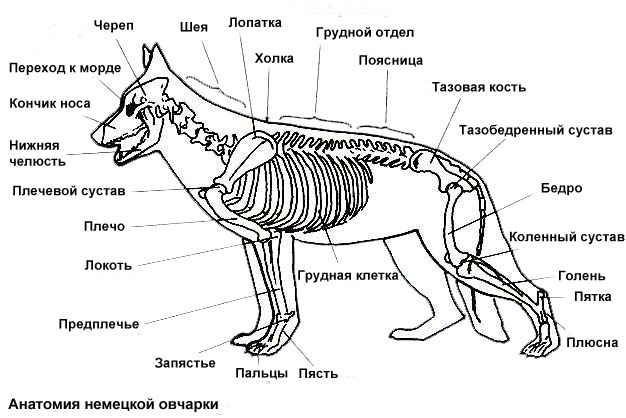
This emotional dog is very obedient, easily adapts to any environment, shows indifference to the owner's commands, performing them with joy. It attacks only by the order of the owner, while the rest of the time it remains calm and attentive, friendly to the unchanging environment,. Demonstrates courage, shows caution to strangers "strangers." Possesses courage, determination and confidence. Caring, submissive, faithful - these qualities make this dog breed worthy of a friend, mostly invaluable for protection.
The standard German shepherd evokes a sense of primitive power. Thin mind, animal flexibility express a purebred predisposition. It is about such animals that they say: “There is a healthy mind in a healthy body.”
For all these reasons, a standard has been adopted that implies the physical and psychological properties of the breed. He expresses the external characteristics of the dog. Quality improvements have focused on the correct anatomical structure, the distinctive aspects of which are a healthy disposition and a beautiful nature.
Only experts with great practice can determine the susceptibility of the German Shepherd Dog to the regime and service. They check the certification of dogs for mental state and physical fitness.
The standard of the breed is affected by all sorts of flaws. A shortage of it or an excess leads to various deviations. Such as cowardice, excessive excitability, apathy, nervousness, low performance. Incorrect body constitution, small testes, posture defect, lack of pigment - albinos, underdevelopment of body build, defects in endurance of the musculoskeletal system, etc.
Now consider all of this in more detail.
Exquisite appearance, discipline, energy, accuracy - exemplary features of the breed. Pedigree dog with excellent sense of smell and absolute hearing aid, stable central nervous system. Athletic and large build slightly stretched, above average size.
The ratio of height and length of 9:10, respectively, growth less than the length of somewhere by 10%.

Average height, fixed by standard:
- For males - 63 cm;
- For bitches - 56 cm.
Departure by 2 centimeters is possible. Changes in different directions from the average height significantly reduce the dignity of the pet.
The constitution of the body guarantees the feasibility of a long run, protects the wool from natural weather influences.
Sexual characteristics of the cables and bitches are extremely pronounced. The manifested, developed two testes of the cables are located in the scrotum.
Now consider the exterior of the German Shepherd, the prevailing characteristics, the preservation of which is necessary when breeding breeds.
Musculoskeletal system
The spine is the basis of the body, the rest of the dog depends on its ratio.
With an exact correspondence of length and symmetry to height, the bones form an excellent motor system. There is a feeling of movement, devoid of tension. With undisturbed running, the limbs of the dog move in a diagonal progression, forming a solid line from the end of the tail to the end of the ears.
Height is combined as follows: the front legs are shifted the same distance as the hind legs, approximately to the middle of the body. Any shift of the hind legs reduces strength and strength.
Limbs
front part
Inspection on either side shows that the front legs are straight, on which are rounded, durable pads with strong claws. When viewed from the front, it is clear that the legs are parallel. On the long shoulder are smooth powerful shoulder blades and shoulder levers. The ideal angle between them is 90 degrees, 110 degrees is permissible.
The length is a little more than height, somewhere around 55-58%. Elbows pressed to the chest and laid back strictly. When moving, or in a position of calm, they cannot be twisted or shifted.
A proportional, strong forearm forms a slope of 20-22 degrees. If the slope is less than 20 degrees, this expresses a negative impact on durability and quality.
Disadvantages: Extremely steep front limbs is a flaw.
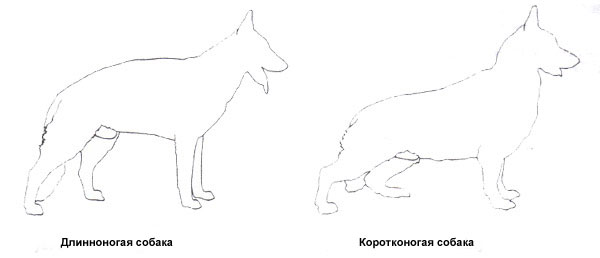
Rear part
Seen from behind, the legs are straight and slightly set aside behind the line of the ischial tubercles. Muscular, equal legs, connecting with the thigh, form a knee angle of 120 degrees. Well-defined hock joints are strong and lowered. On the oval, compact paws are dark, durable pads with strong claws. At an early age, dewclaws are removed.
Disadvantages: A defect is a straight angle of articulations.
Housing
Considered to be a trotter, the German Shepherd has a slightly extended constitution. Accordingly, the length of the body itself exceeds the height at the withers by 110-115%. Such a constitution of the body allows the Germans to move sufficiently carelessly and economically.
Tail
A well-grown fluffy tail is bent and lifted during movement. Whereas, in a calm state, it hangs down, forming an arc, with a small slant. Artificial intervention in the correction is absolutely impossible.
Disadvantages: The tail should not be extremely short and screwed ring.
Neck
At rest, a strong, muscular neck is at an angle of 45 degrees relative to the body, and has no skin folds. When excited, the dog holds its neck high, while during the trot it is at the level of the back, forming a flat line.
Disadvantages: The disadvantages include too long, or vice versa, short neck, the presence of folds on the skin.
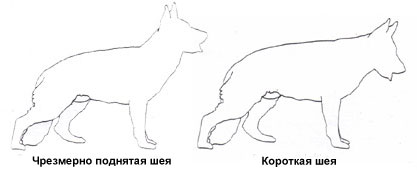
Chest
A discreetly wide, deep chest forms an angle of 48 degrees from the height at the withers. The developed lower part is sharply outlined and oblong. The ribs reaching the sternum are at the level of the elbows, attached to the spine with strong muscles.
Disadvantages: Such flaws of the breast, as too large or vice versa - small size; a hollow can cause elbow joints to move.
Loin
Since the chest is far behind, the loins are relatively short. At the same time it is extremely developed and wide.
Disadvantages: Deviations from the norm - too long loin.
Stomach
Absolutely tucked up.
Disadvantages: Defect is considered too tight, lowered or straight belly.
Back
The strong and direct back has the developed muscles. At the same time the gap between the withers and the croup is small.
Disadvantages: The defect is determined in too narrow a back. Also defects are the humpbacked and arched back.
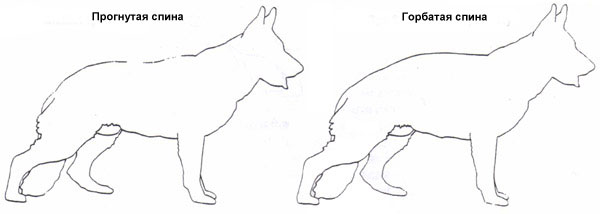
Croup
A long croup smoothly turning at the base of the tail slightly falls to the top line at an angle of 23 degrees. The bony base is created by the sacrum and the hip bone.
Disadvantages: Short, horizontal or sloping croup is unsuitable.
Withers
Unlike the back, the withers are well defined. The smooth translation of a rather long and high withers to the back forms a slight slope.
Hips
Volumetric thighs have a strong muscle group.
Color
After the change of wool, you can determine the final color of the breeding puppies. With the obligatory black color of the nose, the following basic and very common colors are recorded: zona-gray, black-necked, black. About 90% of dogs have exactly black coat. The saturation of this color is modified: from black to red.
Disadvantages: Too light inner surface, white marks on the chest are a defect. The red tip of the tail is also considered unacceptable.
Wool
To the touch, the harsh hair on the head is shorter and softer than on the legs, fingers, neck and on the back of the ears. On the hips, it forms a semblance of pants.
- normal coat;
- long-haired breeding dog;
- longhair shepherd.
Disadvantages: Too thick wool of large length is considered a defect. Especially on the tail.
Head
Not very massive wedge-shaped head in harmony with the size of the body, accounting for 40% of the height of the breeding dog.
Top part
This part of the head, which is 50% of the total length, when viewed from above equally tapers to the nose and has the shape of a wedge.
Disadvantages: A non-proportional head is a defect.
Forehead
Slightly convex when viewed from the side, the forehead has a faint groove in the middle.
Cheekbones
Cheekbones not protruding forward are rounded on the side.
Lips
Thin, dense lips should be dry to the touch.
The jaw
A healthy jaw should have a full set of strong teeth - 42 pcs. (22 in the bottom row, 20 - in the top). Scissor bite required, in this form the upper incisors close the lower. Replacement of dairy (28 pcs.) With indigenous occurs within five months.
Disadvantages: The defect is yellow plaque and broken, age-worn teeth that interfere with proper bite. Light lower jaw says deviation from the desired body type.
Ears
High-level, wide, at the base of the ears are of medium size. They are directed forward by the sink, have a pointed look. Although the puppies of this breed up to six months, during the replacement of teeth, they can hang, with the direction inside. In an excited or lying state, a pedigree dog can press the ears. This is not considered a violation.
Disadvantages: Semi-erect ears hanging on soft cartilage.
Eyes
Asymmetrically set almond-shaped eyes are of medium size. Their tone is the same as coat color, presumably dark. The clever expression of the eyes is slightly expectant.
Disadvantages: Deep-set bug-eyed eyes that are too light in color.
Conclusion
A noble and well-coordinated German shepherd must have absolutely all the pronounced properties of its magnificent breed.
Any offshoot of the standard indicates a lesser tribal conformity of the dog.
German shepherds were bred in Germany, receiving its name from the nickname of the shepherds of sheep "sheepdogs". In ancient times, such dogs acted as herding assistants, helping to save livestock from the attack of wild animals.
However, later the dogs of the German shepherd began to use as service dogs. At present, representatives of this breed are mostly established for guarding home, conducting search services, etc.
German Shepherd Dogs are medium-sized animals with well-developed muscles and a slightly elongated body. Balanced, self-confident, absolutely sincere and well-balanced - these are essentially the German Shepherd dogs.
The growth standard of the German Shepherd is determined by measuring the perpendicular from the floor surface to the withers of the dog.
Thus, the ideal growth of German Shepherd dogs is 60-65 cm with a weight of 30-40 kg, while the growth of females ranges from 55 to 60 cm with a weight of 22-32 kg.
Housing
The back of the German Shepherd is strong, powerful with well-developed muscles. The croup, ideally, is long, slightly falling down (approximately 23 ° to the horizontal surface) and evenly turning into the base of the tail.
 The chest should be moderately wide, and the bone itself should be long and pronounced. The depth of the chest is about 45-48% of the height of the withers. Rib section moderately arched. Barrel chest is not allowed as well as flat ribs.
The chest should be moderately wide, and the bone itself should be long and pronounced. The depth of the chest is about 45-48% of the height of the withers. Rib section moderately arched. Barrel chest is not allowed as well as flat ribs.
The tail should reach the hock, but it should not be longer than the middle of the metatarsus. Keeps gently hanging bend, when excited and during movement slightly lifts, not crossing the horizontal line.
The underside of the tail has wool that is longer than the upper side.
Head and muzzle
The head should be wedge-shaped, which corresponds to the standard size (40% of the height of the withers). In appearance, it should be dry, and the distance between the ears is moderate. The frontal part is slightly convex, without visible recesses.
The ratio of the skull to the muzzle is 50% to 50%, with a width equal to its length. On the top view, the skull of the German shepherd should be evenly tapering from the ears to the nose.
By virtue of well developed jaws, powerful bite, teeth - healthy white color (completeness according to the formula - 42 teeth). The back of the nose is straight without deflections or humpbacks. The nose is always black.
Eyes should be of medium size, almond-shaped, not convex in shape, set slightly obliquely. Pupil color, ideally, as dark as possible.
The ears are of medium size, erect, pointed. Keep upright, have the same direction up and put the sink forward.
The neck is strong, muscular, with no visible suspensions on the throat, at an angle of 45 ° to the horizontal plane.
Limbs
The forelegs should be absolutely parallel, the shoulder blades and shoulder joint tight to the body. Elbows - not turned out and not close to each other. The paws are round, well-assembled and arched, the pads are hard but not fragile. The claws have a dark color and a strong structure.
Hind limbs should be slightly set aside, parallel to each other when viewed from behind. Externally, the femoral and tibiae are the same length and form an angle of 120 °. Thighs have well developed muscles.
The hock is pronounced and strong, with a vertical perforated under it. Paws are collected, a little arching, pads have a rigid structure and dark color. The claws have a dark color and a strong structure.
Wool
Ideally, a German shepherd breed should have a thick undercoat. The coat is tight and hard.
On the head, on the front of the limbs, on the paws and toes - the hair is short, in the neck - a little longer and denser. The back side of the limbs has an elongated coat of wool, and moderate feathering is formed on the hips.
Color
German Shepherds have a black color with reddish brown, brown, yellowish, light gray markings.
Small white markings on the sternum are not excluded. The nose should always be black, whatever the color of the dog.
The undercoat is usually light gray in color. White color is considered a marriage of a breed, so it is unacceptable.

